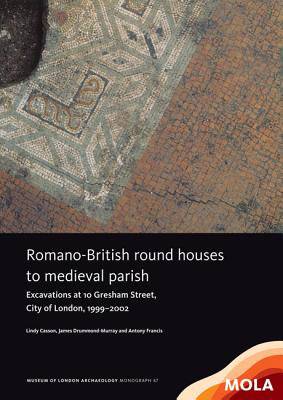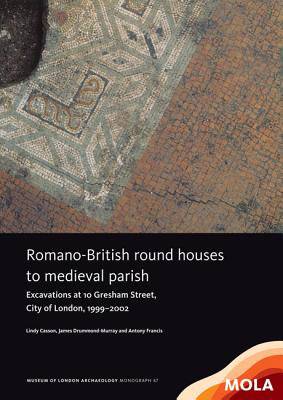
- Afhalen na 1 uur in een winkel met voorraad
- Gratis thuislevering in België vanaf € 30
- Ruim aanbod met 7 miljoen producten
- Afhalen na 1 uur in een winkel met voorraad
- Gratis thuislevering in België vanaf € 30
- Ruim aanbod met 7 miljoen producten
Zoeken
Romano-British Round Houses to Medieval Parish
Excavations at 10 Gresham Street, City of London, 1999-2002
Lindy Casson, James Drummond-Murray, Antony Francis
€ 41,95
+ 83 punten
Omschrijving
Good preservation in the western part of 10 Gresham Street has led to an unusually complete picture of the archaeological sequence.
The discovery here of the largest group of Romano-British round houses yet excavated in London, clustered round a rectangular building, is of considerable significance for the Iron Age-Roman transition. Moreover, the site's main north-south road seems to have been key to determining the layout of this whole area while evidence pointing to sporadic fires in the 2nd century AD casts new light on the idea of a single, catastrophic event. Significant finds include a double gold finger ring of the 1st century AD, while close study of face pots and tazze leads to a rethinking of their possible ritual functions.
Abandoned from the late 4th/early 5th century AD until the 10th century, by the 12th century the site boasted at least four masonry buildings. The remains of several rare and expensive glass display vessels found in a 13th-century refuse pit indicate the presence of an extremely affluent household. Later, two taverns stood on the site or very close by, and significant numbers of vessels for storing and serving ale and wine were recovered. Considerable truncation of post-medieval structures and deposits, however, means that only the deepest cellars and cesspits survived from that period.
The discovery here of the largest group of Romano-British round houses yet excavated in London, clustered round a rectangular building, is of considerable significance for the Iron Age-Roman transition. Moreover, the site's main north-south road seems to have been key to determining the layout of this whole area while evidence pointing to sporadic fires in the 2nd century AD casts new light on the idea of a single, catastrophic event. Significant finds include a double gold finger ring of the 1st century AD, while close study of face pots and tazze leads to a rethinking of their possible ritual functions.
Abandoned from the late 4th/early 5th century AD until the 10th century, by the 12th century the site boasted at least four masonry buildings. The remains of several rare and expensive glass display vessels found in a 13th-century refuse pit indicate the presence of an extremely affluent household. Later, two taverns stood on the site or very close by, and significant numbers of vessels for storing and serving ale and wine were recovered. Considerable truncation of post-medieval structures and deposits, however, means that only the deepest cellars and cesspits survived from that period.
Specificaties
Betrokkenen
- Auteur(s):
- Uitgeverij:
Inhoud
- Aantal bladzijden:
- 250
- Taal:
- Engels
- Reeks:
- Reeksnummer:
- nr. 67
Eigenschappen
- Productcode (EAN):
- 9781907586224
- Verschijningsdatum:
- 30/04/2014
- Uitvoering:
- Hardcover
- Formaat:
- Genaaid
- Afmetingen:
- 211 mm x 300 mm
- Gewicht:
- 1156 g

Alleen bij Standaard Boekhandel
+ 83 punten op je klantenkaart van Standaard Boekhandel
Beoordelingen
We publiceren alleen reviews die voldoen aan de voorwaarden voor reviews. Bekijk onze voorwaarden voor reviews.











